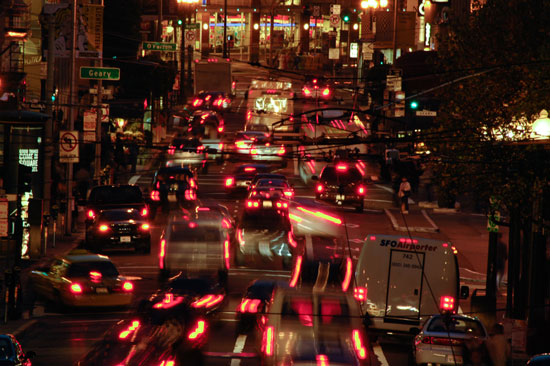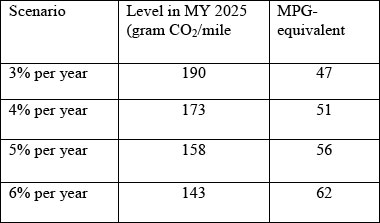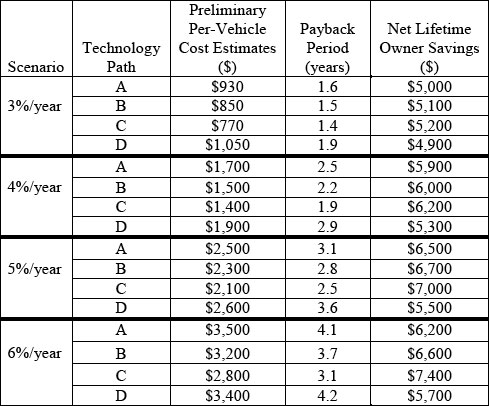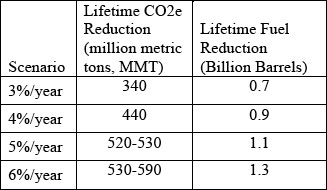
The Obama administration got a lot of attention earlier this year when it raised fuel efficiency rules to an average 35 miles per gallon across the nation's fleet of automobiles that will be produced between 2012 and 2016. Now the Environmental Protection Agency (EPA) and the National Highway Traffic Safety Administration (NHTSA), a division of the U.S. Department of Transportation (US DOT), have laid out an ambitious road map [pdf] to push tougher greenhouse gas emission and fuel economy standards for passenger cars and trucks built from 2017 through 2025, standards that hypothetically could push the national fleet average up as high as 62 mpg.
"We must, and we will, keep the momentum going to make sure that all motor vehicles sold in America are realizing the best fuel economy and greenhouse gas reductions possible," said U.S. Transportation Secretary Ray LaHood. "Continuing the national program would help create a more secure energy future by reducing the nation’s dependence on oil, which has been a national objective since the first oil price shocks in the 1970s."

Today's report provides an initial assessment for a potential national program for the 2025 model year horizon and outlines next steps for additional work the agencies will undertake to meet the yet-to-be established GHG reduction goals. Depending on the scenario eventually chosen, the industry will have to reduce CO2 production across the national car and truck fleet from a minimum 3 percent (or the equivalent of 47 mpg) up to 6 percent (or the equivalent of 62 mpg).
The report outlines the costs and benefits of several approaches for reaching the targets (technology pathways A, B, C, or D), from focusing on reducing vehicle size and advanced gasoline, to relying on gas-electric hybrids and full electric vehicles (EVs). Rule makers assert that even the 6 percent target is achievable with existing technology, though the higher benchmark would require more hybrids and EVs within a manufacturer's fleet.
Even though there will be an increase in the initial cost of vehicles employing more advanced technologies to meet the expected rules, the payoff will be fewer trips to the pump and significant long-term cost savings. From the report:
The preliminary estimated per-vehicle cost increases for a [manufacturer year] 2025 vehicle ranged from $770 to $3,500 across the range of stringency targets and technology pathways. Due to the fuel savings consumers experience by purchasing vehicles with improved fuel economy, the net lifetime owner savings would be $5,000 to $7,400, or a payback period of 1.4 to 4.2 years,

Assuming a 6 percent GHG reduction target, if the industry followed Pathway A, for example, manufacturers would rely on hybrid electric technology (including plug-ins) and would see the highest preliminary per-vehicle cost increase of $3,500, but would save the vehicle's owner $6,200 in fuel over the vehicle's lifetime, with a payback period of 4.1 years. Under the same target but following Pathway C, manufacturers would rely on advanced fuels and smaller vehicles and would see the smallest initial per-vehicle cost increase of $2,800 and would save its owner $7,400 over the vehicle's lifetime, with a payback period of 3.1 years.

The overall impact of the reductions would be quite significant just for the vehicles produced in model year 2025, with varying levels of CO2e reductions depending on the technology pathway and the penetration of hybrids and electric vehicles in the market. If rule makers settled on the 6 percent target, for instance, the lifetime reduction of CO2e from all the cars and trucks manufactured in 2025 would be 530-590 million metric tons and the equivalent of 1.3 billion fewer barrels of oil than the baseline.
"Continuing the successful clean cars program will accelerate the environmental benefits, health protections and clean technology advances over the long-term," EPA Administrator Lisa P. Jackson said in a statement. "We will continue to work with automakers, environmentalists and other stakeholders to encourage standards that reduce our addiction to foreign oil, save money for American drivers, and clean up the air we breathe."
At President Obama's request, the California Air Resources Board (CARB) has participated in the development of the initial analysis and will come up with a technical assessment to inform the subsequent rulemaking process.
CARB spokesperson Stanley Young said Obama had asked CARB to work with the national rulemakers because they have "a great deal of expertise in developing vehicle standards. The President believes we would be able to contribute to the efforts and it would make it easier for California to harmonize its standards with national standards."
The reaction from the Alliance of Automobile Manufactures, which represents BMW Group, Chrysler LLC, Ford Motor Company, General Motors, Jaguar Land Rover, Mazda, Mercedes-Benz, Mitsubishi Motors, Porsche, Toyota, Volkswagen and Volvo, affirmed a commitment to improving fuel economy and reducing GHGs, but said the data in the report was still incomplete.
In a statement, Alliance president Dave McCurdy said, "In the coming weeks, we will carefully review the technical assessment's assumptions regarding factors that will impact vehicle fuel economy increases over this time period.... EPA and DOT should now engage a broad range of independent experts to undertake a thorough analysis and balance the technological opportunities to improve vehicle and fleet fuel economy with the economic challenges they present - for automakers and American consumers."




